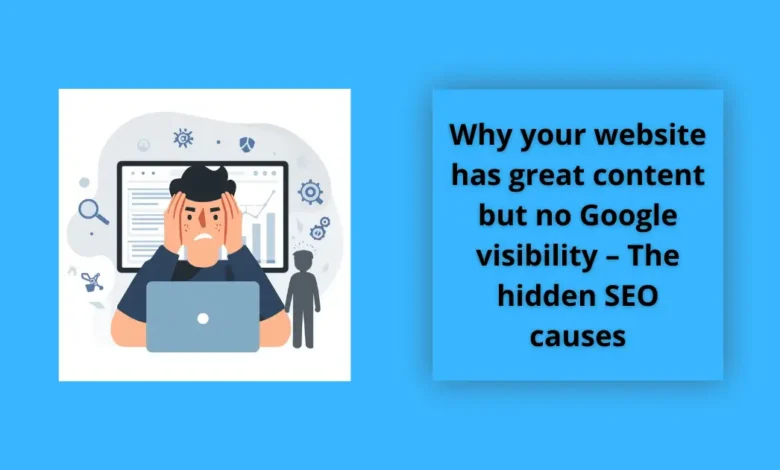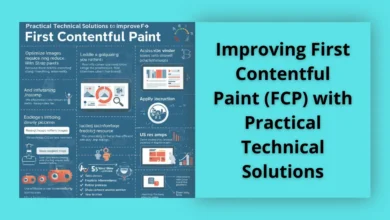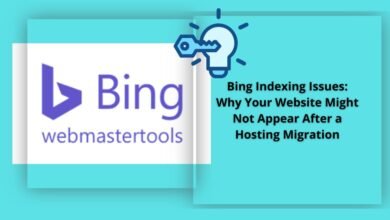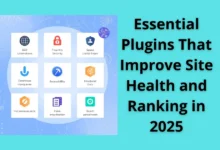Why your website has great content but no Google visibility – The hidden SEO causes

Why your website has great content but no Google visibility – Many websites struggle with low Google visibility despite publishing quality articles. The reasons often lie in overlooked SEO factors that silently suppress your site’s performance.
table of contents
Why your website has great content but no Google visibility: Understanding the hidden SEO causes
It’s a common frustration: you publish well-written, insightful content, but your website still doesn’t appear in Google search results. The problem isn’t necessarily your content—it’s the hidden SEO gaps that determine how Google perceives and ranks your pages. Let’s analyze the unseen reasons behind poor visibility and how to fix them effectively.
Troubleshooting Common WordPress Errors Step-by-Step
1. Weak keyword strategy and poor optimization
Having “great content” doesn’t automatically make it SEO-friendly. If your articles don’t strategically use the right keywords, Google might not understand what your content is about. Many website owners write for readers but forget to write for the algorithm as well.
How to fix it:
- Research long-tail keywords with low competition but high intent.
- Include your main keyword in the title, meta description, subheadings, and body naturally.
- Use semantic keywords (related terms) to give context to Google’s crawlers.
2. Lack of internal linking structure
Even if your content is valuable, without a proper internal link system, Google may not be able to crawl your pages effectively. Internal linking signals which pages are most important and helps distribute ranking power (link juice).
How to fix it:
- Link from older articles to new ones and vice versa.
- Use descriptive anchor text (not “click here”).
- Create pillar pages that connect to multiple related posts.
3. Technical SEO errors blocking indexation
Sometimes your content never gets indexed because of technical issues such as:
- Robots.txt blocking Googlebot.
- “Noindex” tags mistakenly added.
- Slow site speed or mobile errors.
- Poor URL structure.
How to fix it:
- Use Google Search Console to check “Coverage” and “Indexing” reports.
- Fix crawl errors and submit a new sitemap.
- Test your website with PageSpeed Insights and Mobile-Friendly Test.
4. Low-quality backlinks or no backlink profile
Backlinks remain one of Google’s strongest ranking signals. Even if your content is great, without external validation (links from other websites), Google has no reason to rank it above competitors.
How to fix it:
- Reach out to niche-related blogs for guest posting.
- Share your articles on platforms like LinkedIn and Reddit.
- Use tools like Ahrefs or Semrush to analyze competitors’ backlinks.
5. Thin engagement metrics and short dwell time
Google tracks user interaction as a trust signal. If readers leave your site quickly or don’t explore other pages, it reduces your site’s perceived value.
How to fix it:
- Start each article with a strong hook and visual appeal.
- Break long paragraphs for readability.
- Use images, bullet points, and callouts to enhance engagement.
6. Ignoring search intent
You might write detailed content, but if it doesn’t match what users actually search for, it won’t rank. Search intent (informational, transactional, navigational) dictates which content appears on top.
How to fix it:
- Analyze top-ranking pages for your keyword.
- Understand whether users want a guide, product, or quick answer.
- Structure your article to directly satisfy that intent.
7. No consistent publishing or content updates
Google rewards freshness and consistent updates. If your blog posts are outdated or your publishing schedule is irregular, Google’s crawler might visit your site less often.
How to fix it:
- Update older articles with new data and reindex them.
- Publish regularly (even one post per week helps).
- Include publication and last-updated dates.
8. Weak meta descriptions and titles
Even if you appear on search results, poor titles and descriptions can lead to low click-through rates. CTR affects SEO indirectly.
How to fix it:
- Include your main keyword in both title and meta.
- Keep meta descriptions under 160 characters.
- Use emotional and action-driven wording.
Conclusion
Your website can have the best content in the world, but if it’s invisible to Google, it’s like shouting into a void. True SEO success requires balancing content quality with technical precision, keyword intelligence, and ongoing optimization. By uncovering and fixing these hidden SEO causes, you give your great content the visibility it deserves.
FAQ
1. How long does it take for SEO improvements to show results?
Usually between 3–6 months, depending on your niche, competition, and site authority.
2. Can great content alone improve Google rankings?
Not anymore—content quality must be supported by SEO best practices like keywords, backlinks, and technical health.
3. How often should I update my website content?
At least once every 3–4 months, especially for evergreen or technical articles.
4. What tool is best for detecting SEO errors?
Google Search Console for free insights, or premium tools like Ahrefs, Semrush, and Screaming Frog for deep audits.
5. Does user engagement affect rankings?
Yes, Google monitors user behavior like dwell time, bounce rate, and CTR to estimate content value.
Discover more from Feenanoor
Subscribe to get the latest posts sent to your email.





